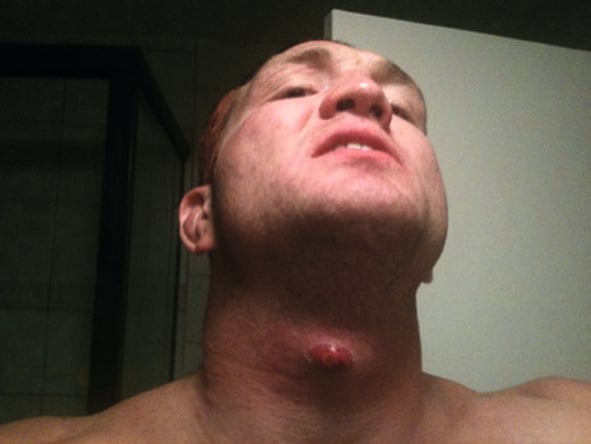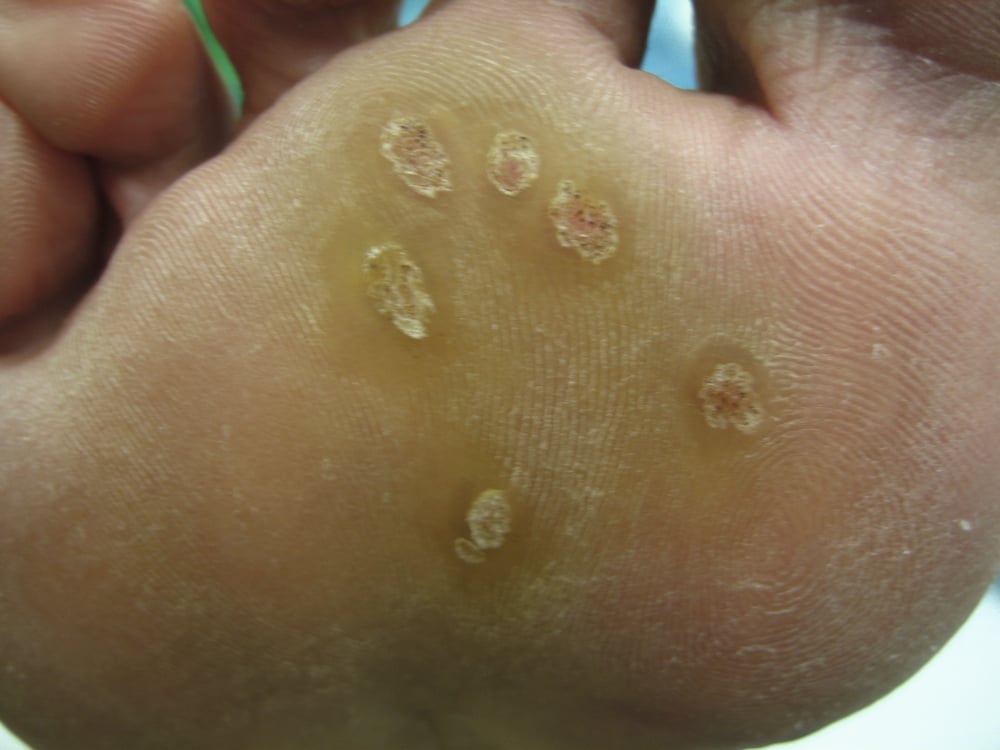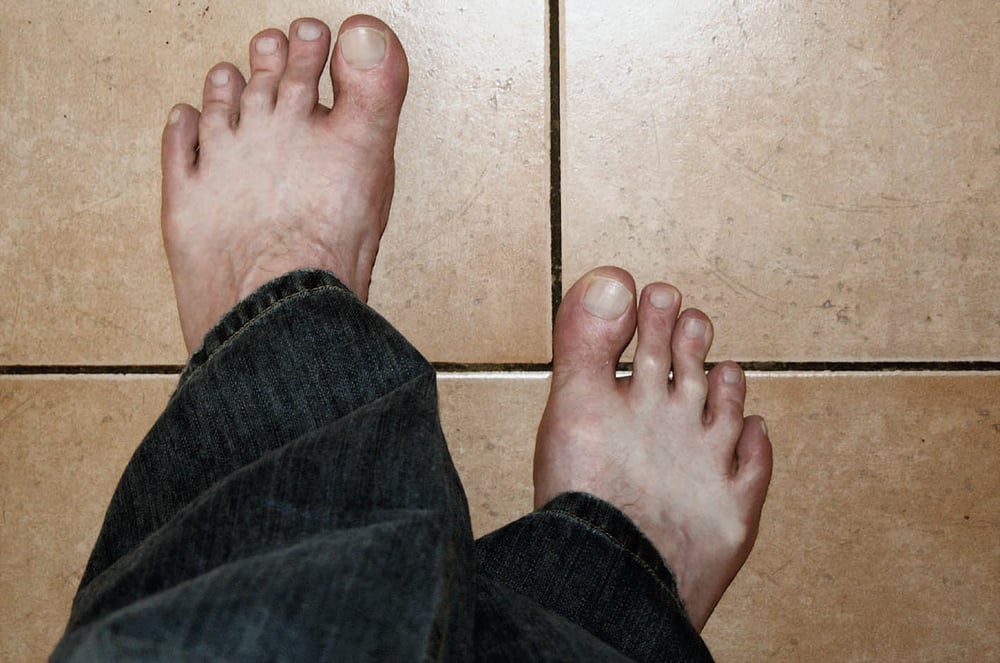
Issue 093
October 2012
Is dirty footwear inside the Octagon ensuring fighters are leaving the cage with much more than a title belt? Fighters Only correspondent Elliot Worsell investigates…
The local high school brass band, complete with flying cheerleaders, has marched the length and breadth of the local neighborhood, straight through the doors of your gym and right across the grappling mats, treading the dirt from the soles of a dozen shoes all over the practice area. You stand and watch, poised, warmed up, ready to make a crucial decision.
Do you unleash a fusillade of expletives and hound them out the door whilst reaching for the mop bucket, or simply carry on regardless and immerse yourself in mud and all manner of bacteria?
You’d be a fool to do the latter, of course, but isn’t that exactly what is happening at pretty much every mixed martial arts event across the planet, including those on the biggest stage of all – the Ultimate Fighting Championship – on any given Saturday night? Pom-pom waving cheerleaders aside perhaps, but certainly street shoes – and plenty of them. In fact, at UFC 148 in July, around a dozen people invaded the Octagon following the chief support bout between Forrest Griffin and Tito Ortiz, all of whom would have been wearing shoes, some relatively cleaner than others, but all harboring some kind of bacteria.
The number of intruders proved to be above average compared to earlier in the night, but still, following all nine previous bouts the Octagon also swelled. Subsequently, when the time came for main event stars Anderson Silva and Chael Sonnen to settle their differences at the MGM Grand Garden Arena, at least 75 individuals – make that 150 individual shoes – had already graced the Octagon canvas.

OK, no big deal, you might be thinking, this sort of behavior is commonplace in MMA and has yet to be a cause for concern. Referees, trainers, television crew and the master of ceremonies are all part of the scenery of any event. Indeed, so too are the army of backslappers who suffocate the victorious fighter at the bout’s conclusion. But let’s recall when the Unified Rules were first drawn up and wrestling boots were banned, purely for sanitation reasons, and ask why shoes are allowed onto the canvas.
In a recent study, researchers at the University of Arizona found nine different species of bacteria on people’s soles, the kind of bacteria that can and does cause infections in our stomachs, eyes and lungs. Moreover, the study showed that bacteria tend to live and fester longer on our shoes than in other places, mainly due to the fact that as we walk we constantly pick up new debris that then feed the growth of more bacteria. In short, these things stick around on our shoes and are about as hard to shake as a Georges St Pierre takedown.
The study, funded by Rockport shoes, was carried out by Dr Gerba, who pinpointed a variety of nasties found on the soles of shoes; including E. coli, which is known to cause intestinal and urinary tract infections; klebsiella pneumonia bacteria, a source of wound and bloodstream infections as well as pneumonia; and serratia ficaria, a rare cause of infections in the respiratory tract and wounds.

Those bacteria, Dr Gerba maintains, are all found in fecal material and are commonly picked up from floors in public restrooms and outside from animal excrement. “The bacteria live longer because you’re accumulating food (for the bacteria) on the bottom of the shoes,” he says. “The shoes are, in essence, becoming a bacteria cafeteria. We didn’t do a survival time, but they were surviving longer than they would on a desktop.”
This bacteria also tends to transfer seamlessly from surface to surface, meaning anything clinging to the sole of one’s shoe can very easily be left lying on a ring canvas if given the invitation. Researchers tested to see if bacteria on shoes would transfer to the tile floors in a house and discovered that more than 90% of the time it did. This means that, if, let’s say, 164 shoes are touching canvas on any one night then, yes, there seems to be a fair chance something will be left by way of an unwanted souvenir.
It doesn’t really have to be this way, either. After all, enter any self-respecting gym and you’ll find protective equipment used when two fighters spar and, of course, gym mats kept as clean and germ-free as possible. There is a conscious effort to eliminate the problem pre-fight. Jiu-jitsu mats are accustomed to a constant spray down, as frequent use by bare-footed and often bare-bodied individuals leaves them susceptible to a laundry list of viruses, bacteria and fungi (see below).
Remember, the dreaded staph infection has already put paid to a number of highly anticipated bouts over the years, and if one guy hasn’t washed or showered properly on a given day, he leaves the whole gym and everybody who comes into contact with him open to the very real and gruesome possibility of picking up something they didn’t want. The rise in these kind of infections has shone the light on the well-being of jiu-jitsu mats and gyms in general, and you’ll now find it difficult rolling anywhere without the lingering stench of disinfectant somewhere beneath your nose.

Of course, one of the more infamous staph infections of recent times was caught not from a gym roll-around but, shockingly, an actual fight. Jason ‘Mayhem’ Miller could only watch helplessly as he sprouted what looked to be a second Adam’s apple in the days following a comprehensive loss to Jake Shields in 2009 (pic below). The pair went back-and-forth for five rounds for the Strikeforce middleweight championship, and Miller is adamant that along the way he picked up a staph infection from the constant grappling and, specifically, the ‘pimply leg’ of his grapple-happy opponent.
Miller even went as far as to call Shields a ‘zit covered leg humper’ on Twitter soon after the loss. Whatever the actual cause, Miller’s staph was as bad as it gets and such a situation raises the point of in-fight hygiene, as opposed to just gym hygiene. Because, although the intention is to get through training camp unscathed in order to then fight, the need for cleanliness and good health doesn’t stop there either. For the 15 or 25 minutes that two athletes spend in the Octagon, cage or ring together, they need not only to be safe and protected, but also free from bacteria and viruses the way they are when grappling on mats in a gym.

Instantly, a lack of protective footwear and clothing in general, and a tendency to acquire cuts, leaves a fighter susceptible to picking something up on fight night, especially when they’re operating inside a structure that has had a conveyor belt of people walking in and out of it beforehand, each wearing shoes of some description. And, in most cases, these will be the same shoes worn by the individual outside, in their car, on the bus, at the hotel and backstage through the congested corridors of the event venue.
It’s like Andy Dufresne said in The Shawshank Redemption, ‘Who really looks at a man’s shoes?’ Shoes come and go on any given fight night and, so long as nobody is leaving a trail behind, we don’t think anything of it.
The nature of the sport leaves itself open to accidents, but it’s infections and viruses that are the real silent killers at work here, transporting these nasties better than anything else.
Knockouts, cuts and haematomas are occupational hazards, unpreventable in the circumstances, but the cleanliness of the floor is something that can not only be looked at, but improved, especially in the lower leagues, where less emphasis is placed on ensuring the canvas is treated and kept in good condition
The UFC, on the whole, do a solid job of keeping the playpen clean and clear, but, for as long as officials are treading the same space as fighters, in the same shoes they’ve been wearing all day, there appears to be an increased chance of somebody going home with something other than a title belt.

3 Steps to Prevention
1 If your name ain’t down, you ain’t comin’ in
In order to prevent even the slightest chance of bacteria festering on fight night, why not limit the amount of people allowed inside the ring or cage? Seriously, is there any great need for dozens of backslappers to invade the fighting space and suffocate their man following a win? Not really. Limit entry to those who truly count – those required to be a part of the action – and have the rest get their photo opportunities backstage.

2 Disinfectant
Let’s do it the old-fashioned way, sterilize everything in sight and kill off germs with a spray or bowl of disinfectant situated by the cage or ring. As fighters are lined up and decorated with grease before battle, ensure all relevant personalities are as clean as newborns. That way we’ll eradicate the nasty stuff as swiftly as Jon Jones going through the light heavyweight division, crushing everything in sight and, hopefully, making the Octagon a germ-free zone come fight time.

3 Octagon Slippers
Okay, so they wouldn’t be the most fashionable piece of kit, but a pair of snug, non-tread slippers or flip-flops could be just the ticket for germaphobes intent on keeping their canvas clean. A fresh pair could be handed to those in need at each event, and then promptly discarded at the end of the night. In time, we could even start to stylize and emblazon these accessories with event sponsors’ logos. And, ultimately, who wouldn’t want to see ‘Big’ Dan Miragliotta prance around in slippers?
...









